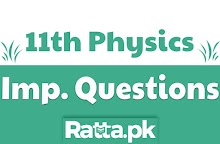Looking for the 10th class physics unit 16 notes? here we have shared the Class 10 Chapter 5 Physics Notes pdf download online.
Download Notes pdf Here
Q.1: What do you mean by alternating current (A.C)?
Ans. The current which changes its direction again and again with time is called alternating current or A.C
Q.2 What do you mean by direct current or D.C?
Ans. The current which does not change its direction of flow is known as direct current or D.
Q.3: What is Joule's Law?
Ans. "The amount of heat energy generated in a resistance is due to flow of electric current is equal to product of square of current T. resistance R and time duration to.c.
WIRt. This is called Joule's Law"
Q.4: What is kilowatt hour (KWh)?
Ans. It is the amount of energy obtained from a power of one kilowatt in one hour. It is equal 10 3.6 megajoule.
Q.5: What is electric current?
Ans. The rate of flow of electric charge through any cross-sectional area is called electric current. Mathematically I =
Q.6: In metals, how electric current is produced?
Ans. In metals the current is produced only due to the flow of free electrons or negative charges
0.7: How current is produced in electrolytes?
Ans. In electrolytes, the current is produced due to flow of both the positive and negative charges
0.8: What do you mean by resistance?
Ans. The property of a substance which opposes the flow of current through it is called resistance.
Q.9 What do you mean by specific resistance?
Ans. The resistance of one-meter cube of a substance is called specific Resistance.
R pof L= Im & A Im then R P
Q.10: Define unit of Resistance (OR) Define Ohm.
Ans. A material has a resistance of one Ohm (1 Ohm) if there is a current of one ampere flowing through it when the potential difference across it is 1 volt.
Q.11: What is drift velocity?
Ans. When we apply potential difference across the ends of the conductor, the free electrons in addition to their random motion have directed motion with a velocity is known as drift velocity
Q.12: What is conventional current?
Ans. The current due to flow of positive charges is equivalent to the current due to how of negative charges in the opposite direction is called conventional current.
Q.13: What is Electromotive force?
Ans. The energy needed to move one coulomb charge through the whole circuit including the battery is called electromotive force or (emf).
Q.14. What is the net result in the absence of electric field?/Why current cannot pass through conductor in normal state?
Ans. In the absence of electric field, the rate at which the free electrons cross any section of the from right to left is equal to left to right, rate is zero, so in spite of the fact that electrons are in motion no current flows through any section of the conductor.
Q.15. What is temperature co-efficient of resistance?
Ans. The change in resistance per unit original resistance per Kelvin rise in temperature is called temperature coefficient of resistance.
RT-R
Mathematical aRT
Q.16. What is parallel combination of resistance?
Ans. If a number of resisters are connected side by side with their ends joined together at common point, then it is called parallel combination.
Q.17. What is equivalent resistance?
Ans A single resistance obtained by replacing a number of resistances in a combination giving similar effects is called equivalent resistance.
Q.18. What is series combination of resistance?
Ans. If the resistances are connected end to end such that the same current passes through all of them, then it is called series combination of resistances.
Q.19. What is galvanometer?
Ans. It is a sensitive instrument which is used to detect the presence of current in circuit.
Q.20. What is ammeter?
Ans. Ammeter is an instrument used to measure electric current.
Q.21. What is voltmeter?
Ans. It is an instrument used to measure potential difference between two points.0.24. What is circuit breaker? Write its working principle.
Ans. A safety device used in place of fuse is called circuit breaker. It breaks the electric circuit if current increases beyond the given rating. It works on the principle of electromagnet
Q.25. How ammeter is connected in circuit?
Ans. In order to measure current in a circuit, the ammeter is connected in series, so the current passes in circuit also passes through the ammeter.
Q.26. Is there any effect on current, when ammeter is connected in a circuit?
Ans. There is no effect upon the current of the circuit, as the resistance of ammeter is very small.
Q.27. How galvanometer is converted into an ammeter? (OR) What is shunt?
Ans. Galvanometer is converted into an ammeter by connecting a suitable low resistance in parallel with the galvanometer which is called shunt
Q.28. How galvanometer is converted into voltmeter?
Ans. Galvanometer is converted in voltmeter by connecting a suitable high resistance in series with the galvanometer.
Q.29. How voltmeter is connected in circuit?
Ans. Voltmeter is always connected in parallel with resistance across which the potential difference is to be measured
You may also like:
This is the post on the topic of the Class 10 Chapter 5 Physics Notes. The post is tagged and categorized under in
10th notes,
10th physics,
Education News,
Notes
Tags. For more content related to this post you can click on labels link.
You can give your opinion or any question you have to ask below in the comment section area. Already 0 people have commented on this post. Be the next one on the list. We will try to respond to your comment as soon as possible. Please do not spam in the comment section otherwise your comment will be deleted and IP banned.








No comments:
Write comments